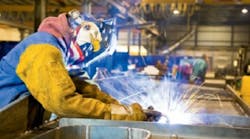While it's not news to manufacturing companies that workers, of any collar, are hard to find, a new report from the Conference Board found that it is harder to find blue-collar workers than white-collar workers. This reverses a decades-long trend in the U.S. jobs market.
As the report details, growing blue-collar labor shortages result from converging demographic, educational, and economic trends in the U.S. economy. As the U.S. population has attained more education, the group of working-age individuals with a bachelor’s degree has grown, while the number of those without one has shrunk.
Other economic trends include the fact the Baby Boom generation, a segment of the workforce that once held many blue-collar jobs, continues to retire in droves. The report also notes that since the mid-1990s millions of non-college graduates have left the labor force due to disability, adding to the worker shortage. And while the pool of blue-collar workers has shrunk, the demand for their services has continuously grown since the 2008 financial crisis.
“In certain instances, companies looking to attract enough blue-collar workers will have to continue increasing wages and, as a result, possibly experience diminished profits,” said Gad Levanon, chief economist of North America at The Conference Board. “But the picture looks very different for the workers themselves. Compared to a few years ago, blue-collar workers are now much more likely to have a job they are satisfied with and experience rapid wage growth.”
Tight labor markets are especially visible in the following blue-collar and low-pay service sectors:
- Production/Manufacturing -- Between 2010-2018, fewer manufacturing jobs were offshored and less productivity growth from automation took place than in the previous decade. This combination has led to a continuous demand for U.S. workers.
- Transportation -- As just one example, the rapid growth in online shopping is creating robust demand for delivery drivers. In addition, workers in transportation jobs tend to be older, a trend that has led to many retirements in recent years.
Over the next decade, the extent of the challenges caused by blue-collar labor shortages will depend largely on three factors: To what extent employers can further automate blue-collar jobs; how many additional individuals are brought back into the labor force; and, how many workers move into blue-collar jobs from other parts of the labor market.
The report recommends the following actions to help alleviate current or potential shortages in the future:
Invest more in automation. Many blue-collar jobs have the potential to become automated in the next decade. Food preparation, manufacturing, and cleaning and maintenance occupations are particularly likely to be automated and, to some extent, already have been.
For certain jobs, reduce education requirements. Amid tightening labor markets, many companies are expanding the supply of talent by lowering education requirements during recruitment and providing basic internal training.
Find locations with greater availability of blue-collar labor. In some occupations, most notably manufacturing, employers have more discretion on where to locate operations and can thus shift some of the work to areas with increased availability of blue-collar labor.




